Building & Marketing High Performing Orgs: McDonald's EFQM Report
VerifiedAdded on 2022/10/09
|13
|2946
|24
Report
AI Summary
This report conducts an in-depth analysis of McDonald's, applying the EFQM Business Excellence Model to assess its performance. The analysis focuses on two key criteria: Partnerships & Resources (specifically sustainable relationships with partners and suppliers and sustainable management of buildings, equipment, and resources) and Processes, Products, and Services (including the definition of key processes and the development of innovative products and services). The report evaluates McDonald's strengths and weaknesses in these areas, drawing on relevant theories and concepts. Furthermore, the report proposes and justifies a supply chain management strategy, specifically EFQM training for suppliers, that McDonald's could implement to drive business excellence. The report utilizes the RADAR methodology to identify key processes. The report concludes with a discussion on the importance of continuous improvement and innovation within McDonald's to maintain its competitive edge.
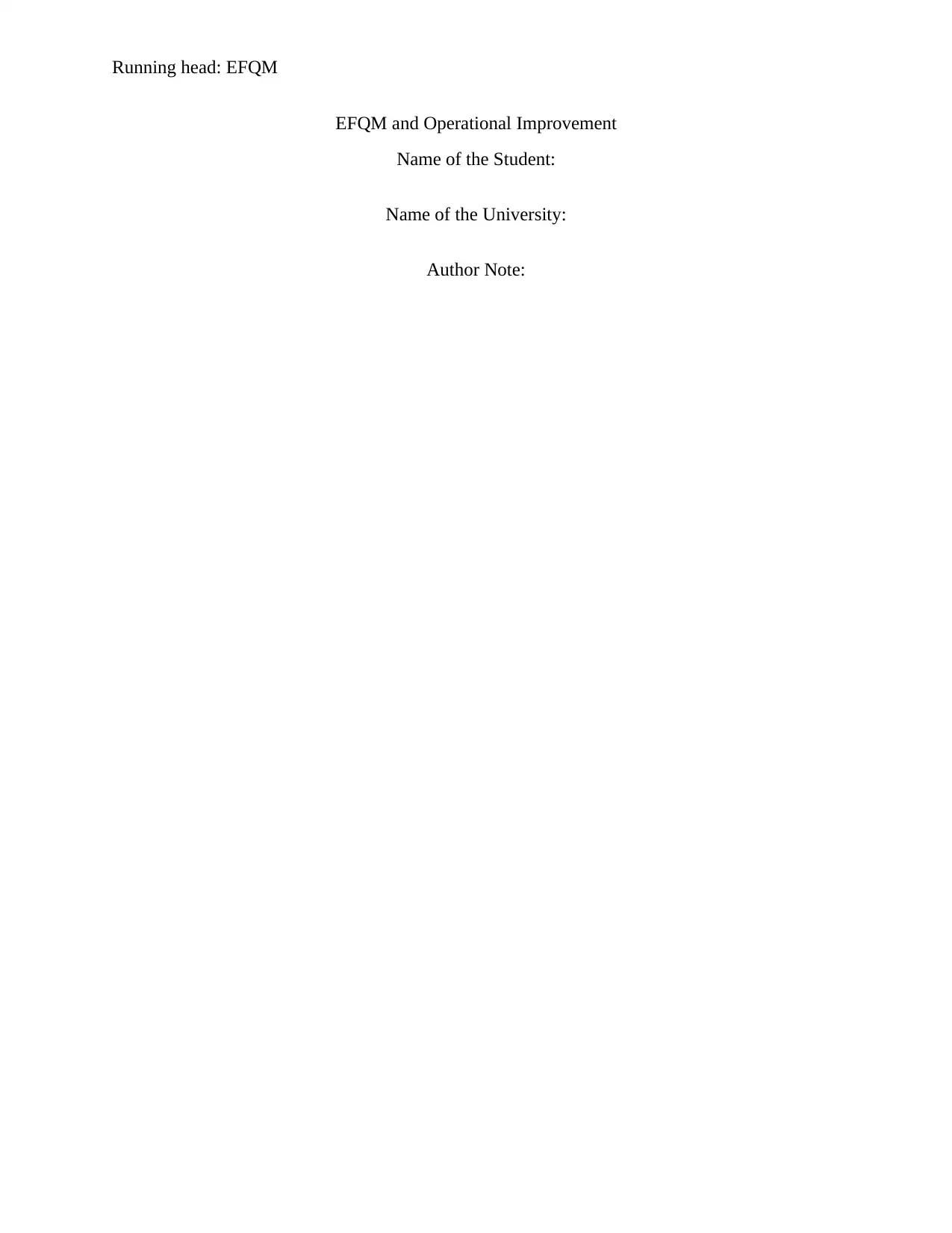
Running head: EFQM
EFQM and Operational Improvement
Name of the Student:
Name of the University:
Author Note:
EFQM and Operational Improvement
Name of the Student:
Name of the University:
Author Note:
Paraphrase This Document
Need a fresh take? Get an instant paraphrase of this document with our AI Paraphraser
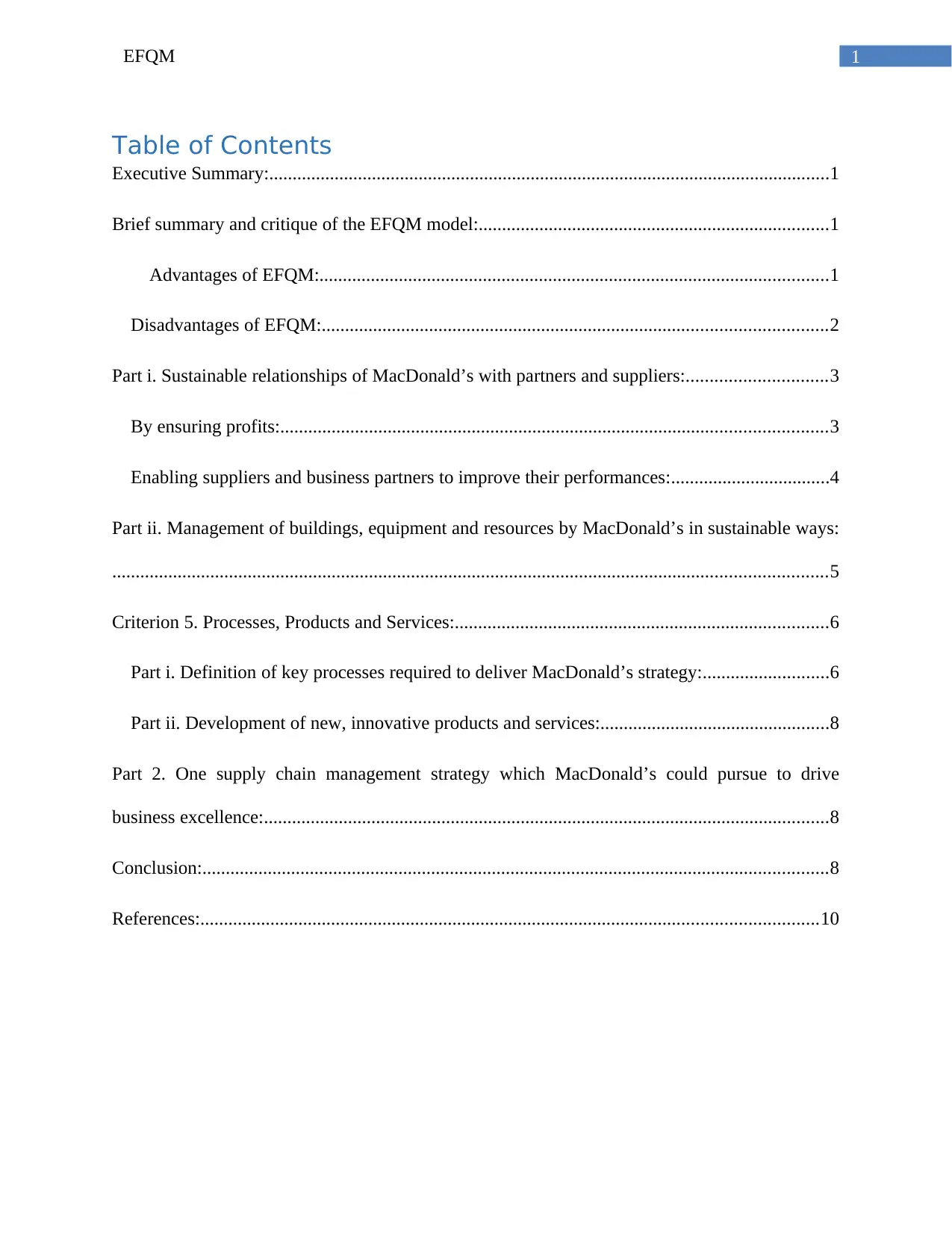
1EFQM
Table of Contents
Executive Summary:........................................................................................................................1
Brief summary and critique of the EFQM model:...........................................................................1
Advantages of EFQM:.............................................................................................................1
Disadvantages of EFQM:............................................................................................................2
Part i. Sustainable relationships of MacDonald’s with partners and suppliers:..............................3
By ensuring profits:.....................................................................................................................3
Enabling suppliers and business partners to improve their performances:..................................4
Part ii. Management of buildings, equipment and resources by MacDonald’s in sustainable ways:
.........................................................................................................................................................5
Criterion 5. Processes, Products and Services:................................................................................6
Part i. Definition of key processes required to deliver MacDonald’s strategy:...........................6
Part ii. Development of new, innovative products and services:.................................................8
Part 2. One supply chain management strategy which MacDonald’s could pursue to drive
business excellence:.........................................................................................................................8
Conclusion:......................................................................................................................................8
References:....................................................................................................................................10
Table of Contents
Executive Summary:........................................................................................................................1
Brief summary and critique of the EFQM model:...........................................................................1
Advantages of EFQM:.............................................................................................................1
Disadvantages of EFQM:............................................................................................................2
Part i. Sustainable relationships of MacDonald’s with partners and suppliers:..............................3
By ensuring profits:.....................................................................................................................3
Enabling suppliers and business partners to improve their performances:..................................4
Part ii. Management of buildings, equipment and resources by MacDonald’s in sustainable ways:
.........................................................................................................................................................5
Criterion 5. Processes, Products and Services:................................................................................6
Part i. Definition of key processes required to deliver MacDonald’s strategy:...........................6
Part ii. Development of new, innovative products and services:.................................................8
Part 2. One supply chain management strategy which MacDonald’s could pursue to drive
business excellence:.........................................................................................................................8
Conclusion:......................................................................................................................................8
References:....................................................................................................................................10
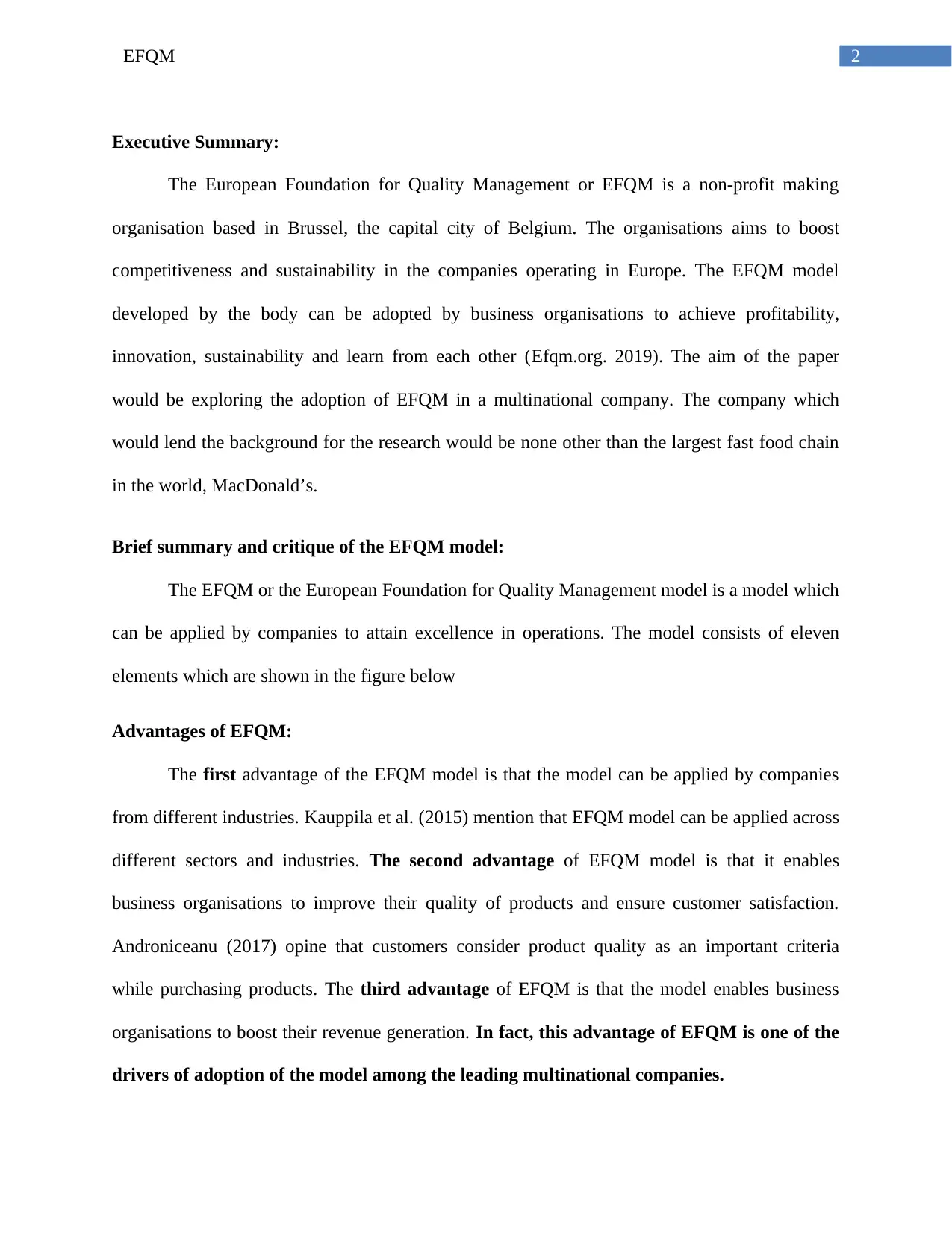
2EFQM
Executive Summary:
The European Foundation for Quality Management or EFQM is a non-profit making
organisation based in Brussel, the capital city of Belgium. The organisations aims to boost
competitiveness and sustainability in the companies operating in Europe. The EFQM model
developed by the body can be adopted by business organisations to achieve profitability,
innovation, sustainability and learn from each other (Efqm.org. 2019). The aim of the paper
would be exploring the adoption of EFQM in a multinational company. The company which
would lend the background for the research would be none other than the largest fast food chain
in the world, MacDonald’s.
Brief summary and critique of the EFQM model:
The EFQM or the European Foundation for Quality Management model is a model which
can be applied by companies to attain excellence in operations. The model consists of eleven
elements which are shown in the figure below
Advantages of EFQM:
The first advantage of the EFQM model is that the model can be applied by companies
from different industries. Kauppila et al. (2015) mention that EFQM model can be applied across
different sectors and industries. The second advantage of EFQM model is that it enables
business organisations to improve their quality of products and ensure customer satisfaction.
Androniceanu (2017) opine that customers consider product quality as an important criteria
while purchasing products. The third advantage of EFQM is that the model enables business
organisations to boost their revenue generation. In fact, this advantage of EFQM is one of the
drivers of adoption of the model among the leading multinational companies.
Executive Summary:
The European Foundation for Quality Management or EFQM is a non-profit making
organisation based in Brussel, the capital city of Belgium. The organisations aims to boost
competitiveness and sustainability in the companies operating in Europe. The EFQM model
developed by the body can be adopted by business organisations to achieve profitability,
innovation, sustainability and learn from each other (Efqm.org. 2019). The aim of the paper
would be exploring the adoption of EFQM in a multinational company. The company which
would lend the background for the research would be none other than the largest fast food chain
in the world, MacDonald’s.
Brief summary and critique of the EFQM model:
The EFQM or the European Foundation for Quality Management model is a model which
can be applied by companies to attain excellence in operations. The model consists of eleven
elements which are shown in the figure below
Advantages of EFQM:
The first advantage of the EFQM model is that the model can be applied by companies
from different industries. Kauppila et al. (2015) mention that EFQM model can be applied across
different sectors and industries. The second advantage of EFQM model is that it enables
business organisations to improve their quality of products and ensure customer satisfaction.
Androniceanu (2017) opine that customers consider product quality as an important criteria
while purchasing products. The third advantage of EFQM is that the model enables business
organisations to boost their revenue generation. In fact, this advantage of EFQM is one of the
drivers of adoption of the model among the leading multinational companies.
⊘ This is a preview!⊘
Do you want full access?
Subscribe today to unlock all pages.

Trusted by 1+ million students worldwide
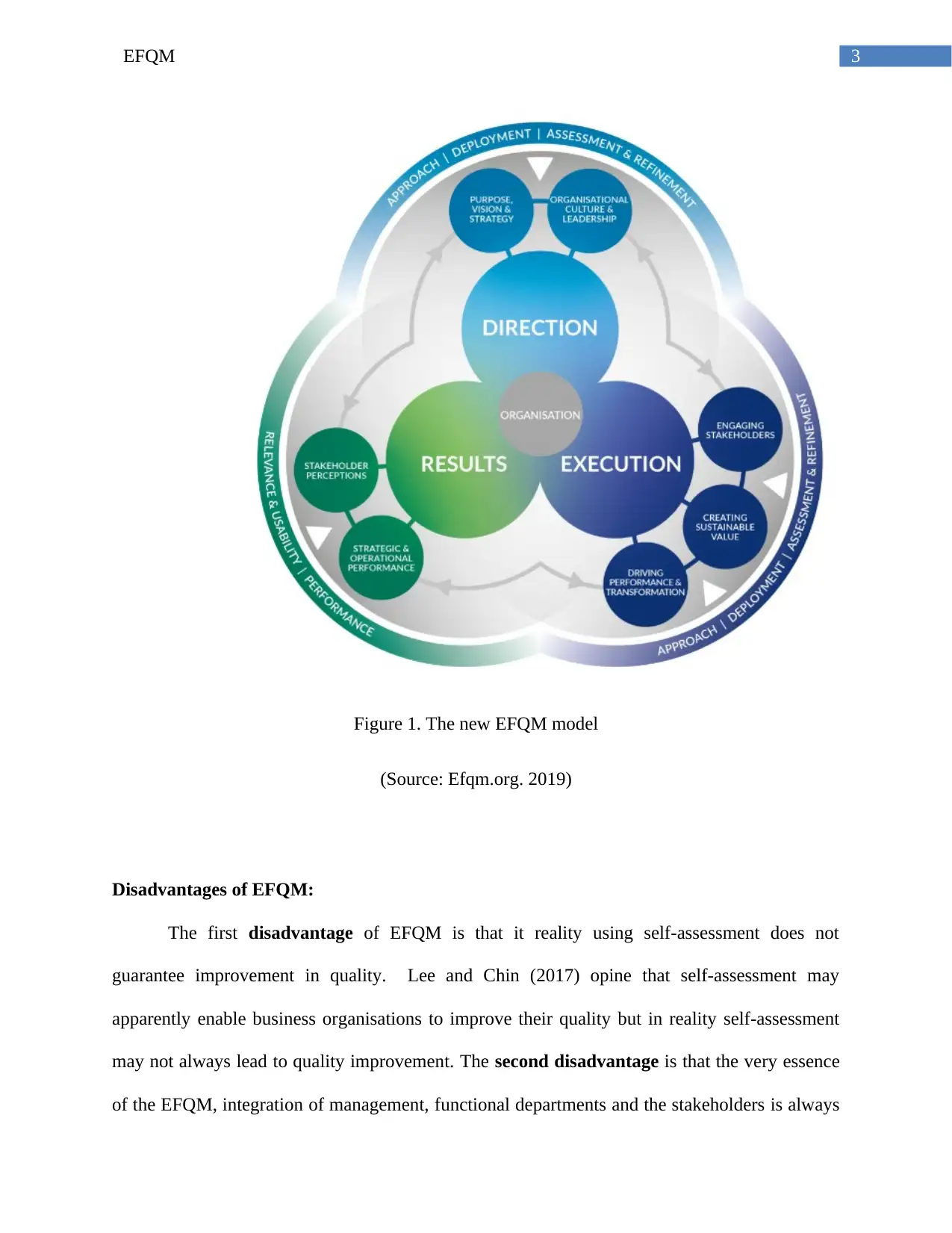
3EFQM
Figure 1. The new EFQM model
(Source: Efqm.org. 2019)
Disadvantages of EFQM:
The first disadvantage of EFQM is that it reality using self-assessment does not
guarantee improvement in quality. Lee and Chin (2017) opine that self-assessment may
apparently enable business organisations to improve their quality but in reality self-assessment
may not always lead to quality improvement. The second disadvantage is that the very essence
of the EFQM, integration of management, functional departments and the stakeholders is always
Figure 1. The new EFQM model
(Source: Efqm.org. 2019)
Disadvantages of EFQM:
The first disadvantage of EFQM is that it reality using self-assessment does not
guarantee improvement in quality. Lee and Chin (2017) opine that self-assessment may
apparently enable business organisations to improve their quality but in reality self-assessment
may not always lead to quality improvement. The second disadvantage is that the very essence
of the EFQM, integration of management, functional departments and the stakeholders is always
Paraphrase This Document
Need a fresh take? Get an instant paraphrase of this document with our AI Paraphraser
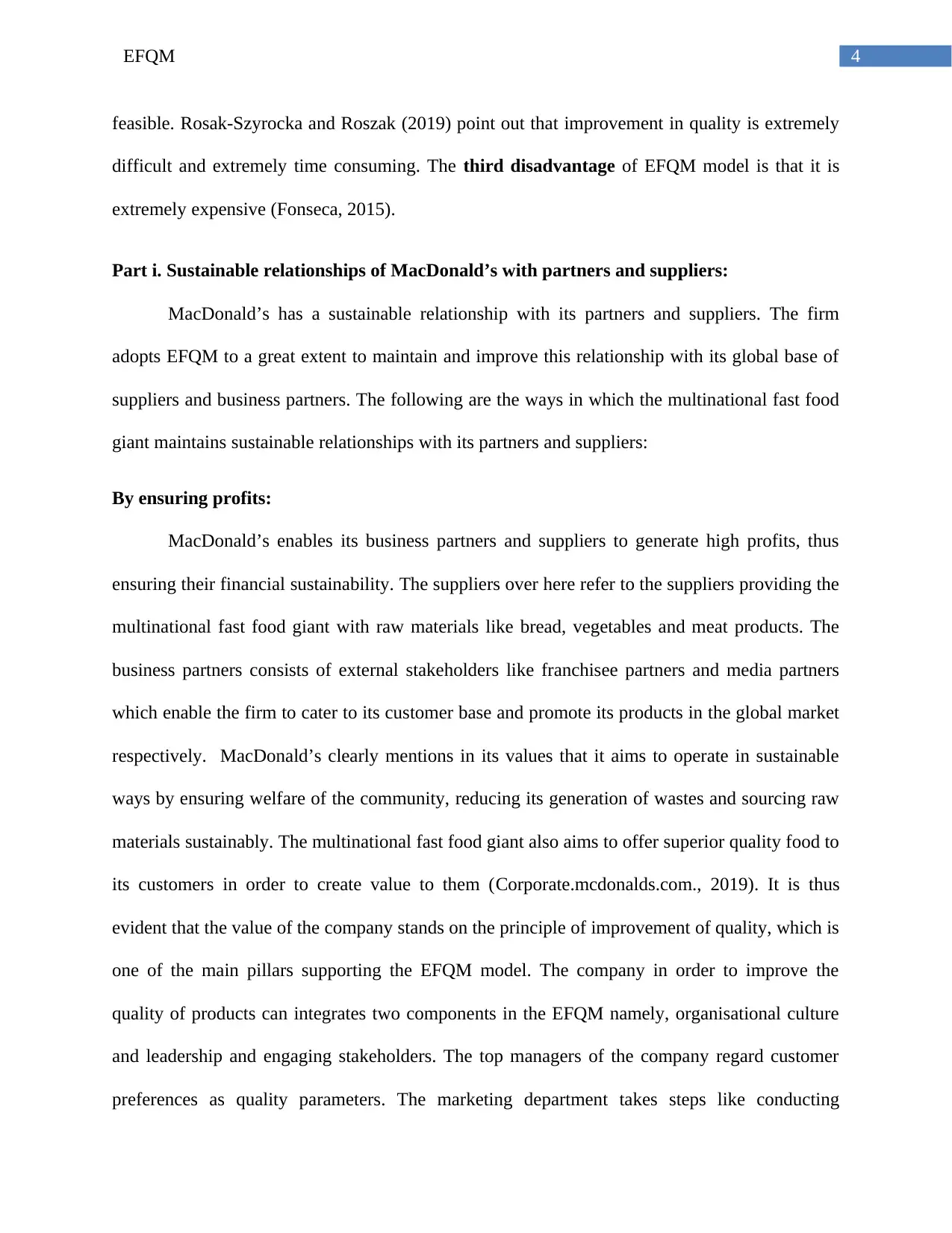
4EFQM
feasible. Rosak-Szyrocka and Roszak (2019) point out that improvement in quality is extremely
difficult and extremely time consuming. The third disadvantage of EFQM model is that it is
extremely expensive (Fonseca, 2015).
Part i. Sustainable relationships of MacDonald’s with partners and suppliers:
MacDonald’s has a sustainable relationship with its partners and suppliers. The firm
adopts EFQM to a great extent to maintain and improve this relationship with its global base of
suppliers and business partners. The following are the ways in which the multinational fast food
giant maintains sustainable relationships with its partners and suppliers:
By ensuring profits:
MacDonald’s enables its business partners and suppliers to generate high profits, thus
ensuring their financial sustainability. The suppliers over here refer to the suppliers providing the
multinational fast food giant with raw materials like bread, vegetables and meat products. The
business partners consists of external stakeholders like franchisee partners and media partners
which enable the firm to cater to its customer base and promote its products in the global market
respectively. MacDonald’s clearly mentions in its values that it aims to operate in sustainable
ways by ensuring welfare of the community, reducing its generation of wastes and sourcing raw
materials sustainably. The multinational fast food giant also aims to offer superior quality food to
its customers in order to create value to them (Corporate.mcdonalds.com., 2019). It is thus
evident that the value of the company stands on the principle of improvement of quality, which is
one of the main pillars supporting the EFQM model. The company in order to improve the
quality of products can integrates two components in the EFQM namely, organisational culture
and leadership and engaging stakeholders. The top managers of the company regard customer
preferences as quality parameters. The marketing department takes steps like conducting
feasible. Rosak-Szyrocka and Roszak (2019) point out that improvement in quality is extremely
difficult and extremely time consuming. The third disadvantage of EFQM model is that it is
extremely expensive (Fonseca, 2015).
Part i. Sustainable relationships of MacDonald’s with partners and suppliers:
MacDonald’s has a sustainable relationship with its partners and suppliers. The firm
adopts EFQM to a great extent to maintain and improve this relationship with its global base of
suppliers and business partners. The following are the ways in which the multinational fast food
giant maintains sustainable relationships with its partners and suppliers:
By ensuring profits:
MacDonald’s enables its business partners and suppliers to generate high profits, thus
ensuring their financial sustainability. The suppliers over here refer to the suppliers providing the
multinational fast food giant with raw materials like bread, vegetables and meat products. The
business partners consists of external stakeholders like franchisee partners and media partners
which enable the firm to cater to its customer base and promote its products in the global market
respectively. MacDonald’s clearly mentions in its values that it aims to operate in sustainable
ways by ensuring welfare of the community, reducing its generation of wastes and sourcing raw
materials sustainably. The multinational fast food giant also aims to offer superior quality food to
its customers in order to create value to them (Corporate.mcdonalds.com., 2019). It is thus
evident that the value of the company stands on the principle of improvement of quality, which is
one of the main pillars supporting the EFQM model. The company in order to improve the
quality of products can integrates two components in the EFQM namely, organisational culture
and leadership and engaging stakeholders. The top managers of the company regard customer
preferences as quality parameters. The marketing department takes steps like conducting
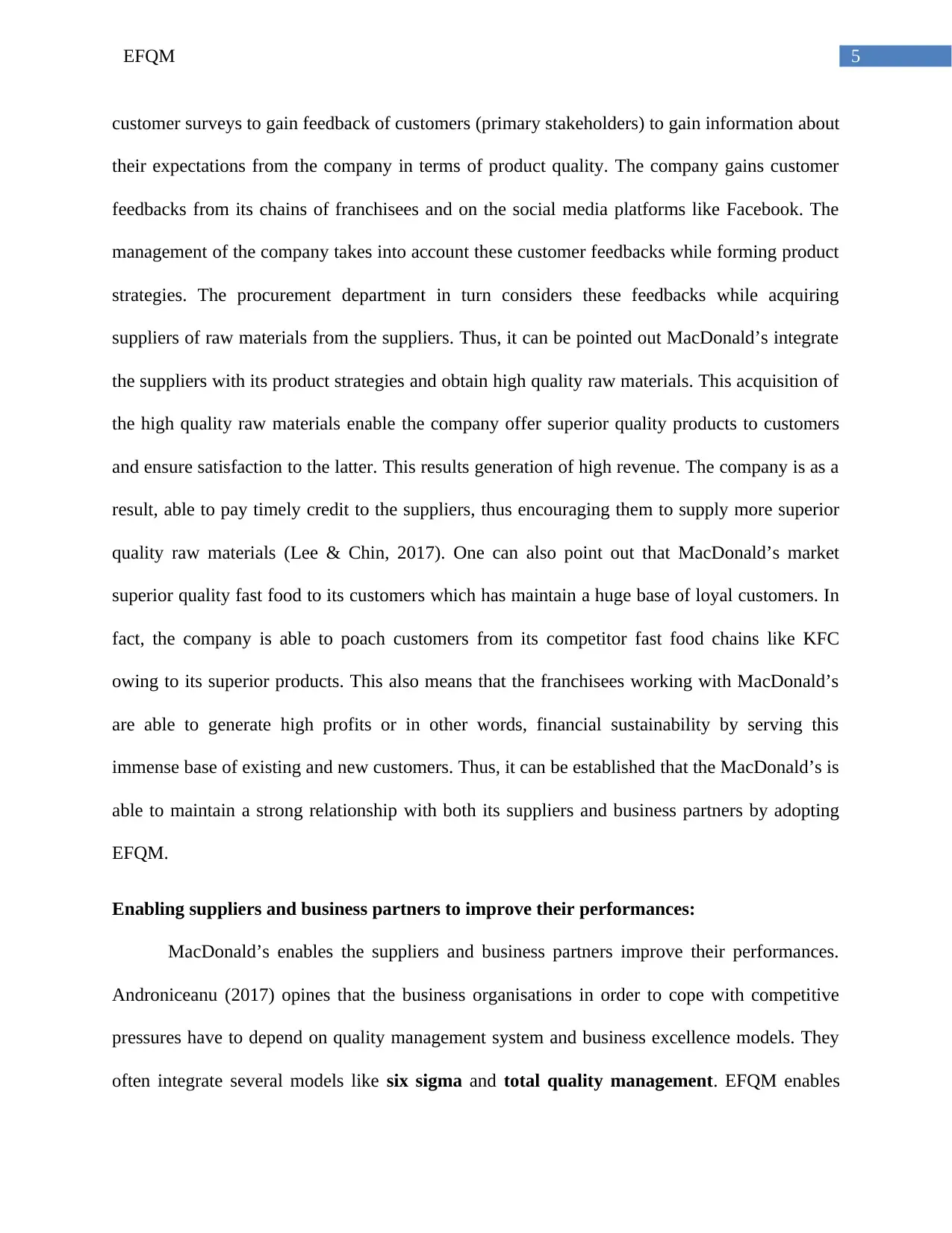
5EFQM
customer surveys to gain feedback of customers (primary stakeholders) to gain information about
their expectations from the company in terms of product quality. The company gains customer
feedbacks from its chains of franchisees and on the social media platforms like Facebook. The
management of the company takes into account these customer feedbacks while forming product
strategies. The procurement department in turn considers these feedbacks while acquiring
suppliers of raw materials from the suppliers. Thus, it can be pointed out MacDonald’s integrate
the suppliers with its product strategies and obtain high quality raw materials. This acquisition of
the high quality raw materials enable the company offer superior quality products to customers
and ensure satisfaction to the latter. This results generation of high revenue. The company is as a
result, able to pay timely credit to the suppliers, thus encouraging them to supply more superior
quality raw materials (Lee & Chin, 2017). One can also point out that MacDonald’s market
superior quality fast food to its customers which has maintain a huge base of loyal customers. In
fact, the company is able to poach customers from its competitor fast food chains like KFC
owing to its superior products. This also means that the franchisees working with MacDonald’s
are able to generate high profits or in other words, financial sustainability by serving this
immense base of existing and new customers. Thus, it can be established that the MacDonald’s is
able to maintain a strong relationship with both its suppliers and business partners by adopting
EFQM.
Enabling suppliers and business partners to improve their performances:
MacDonald’s enables the suppliers and business partners improve their performances.
Androniceanu (2017) opines that the business organisations in order to cope with competitive
pressures have to depend on quality management system and business excellence models. They
often integrate several models like six sigma and total quality management. EFQM enables
customer surveys to gain feedback of customers (primary stakeholders) to gain information about
their expectations from the company in terms of product quality. The company gains customer
feedbacks from its chains of franchisees and on the social media platforms like Facebook. The
management of the company takes into account these customer feedbacks while forming product
strategies. The procurement department in turn considers these feedbacks while acquiring
suppliers of raw materials from the suppliers. Thus, it can be pointed out MacDonald’s integrate
the suppliers with its product strategies and obtain high quality raw materials. This acquisition of
the high quality raw materials enable the company offer superior quality products to customers
and ensure satisfaction to the latter. This results generation of high revenue. The company is as a
result, able to pay timely credit to the suppliers, thus encouraging them to supply more superior
quality raw materials (Lee & Chin, 2017). One can also point out that MacDonald’s market
superior quality fast food to its customers which has maintain a huge base of loyal customers. In
fact, the company is able to poach customers from its competitor fast food chains like KFC
owing to its superior products. This also means that the franchisees working with MacDonald’s
are able to generate high profits or in other words, financial sustainability by serving this
immense base of existing and new customers. Thus, it can be established that the MacDonald’s is
able to maintain a strong relationship with both its suppliers and business partners by adopting
EFQM.
Enabling suppliers and business partners to improve their performances:
MacDonald’s enables the suppliers and business partners improve their performances.
Androniceanu (2017) opines that the business organisations in order to cope with competitive
pressures have to depend on quality management system and business excellence models. They
often integrate several models like six sigma and total quality management. EFQM enables
⊘ This is a preview!⊘
Do you want full access?
Subscribe today to unlock all pages.

Trusted by 1+ million students worldwide
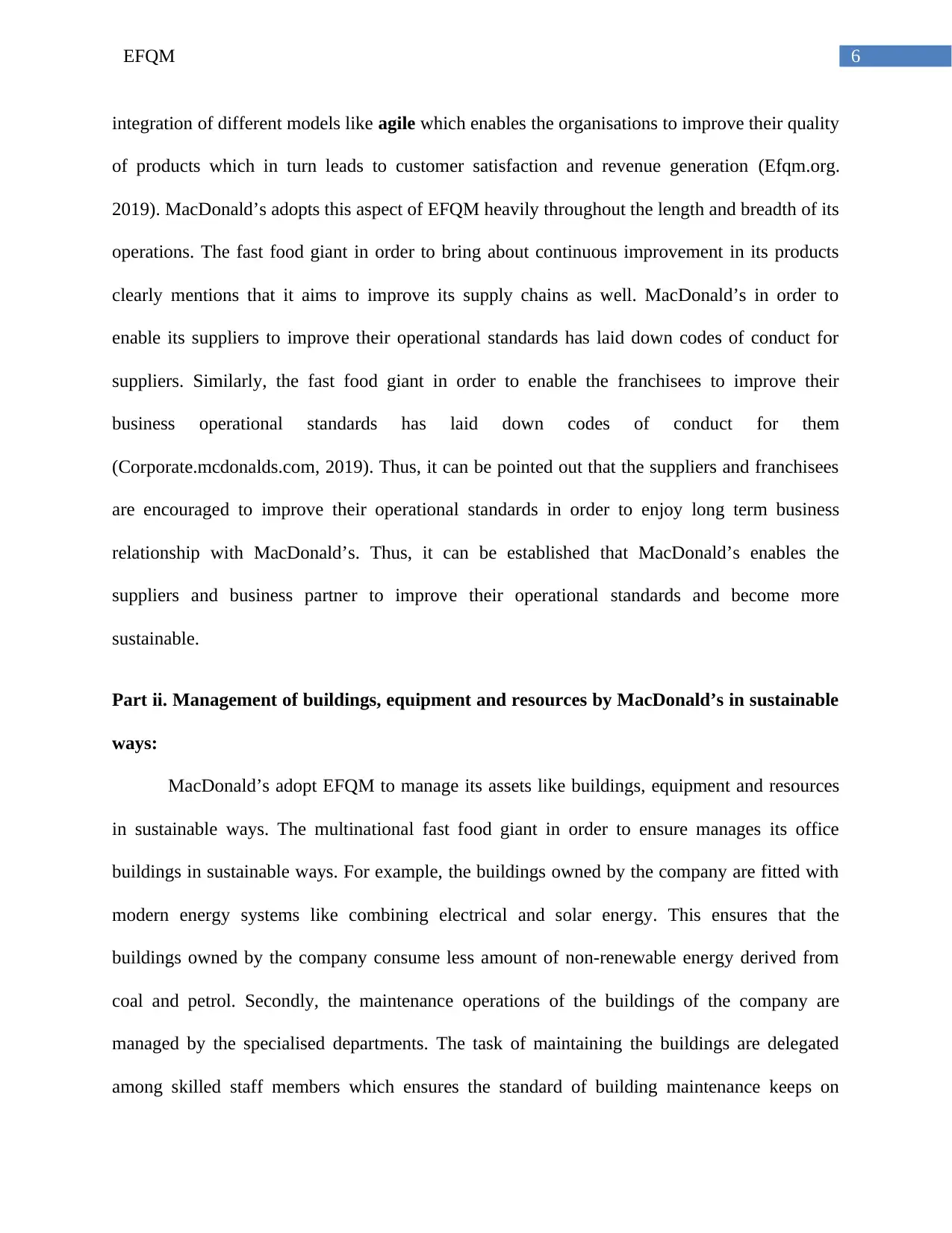
6EFQM
integration of different models like agile which enables the organisations to improve their quality
of products which in turn leads to customer satisfaction and revenue generation (Efqm.org.
2019). MacDonald’s adopts this aspect of EFQM heavily throughout the length and breadth of its
operations. The fast food giant in order to bring about continuous improvement in its products
clearly mentions that it aims to improve its supply chains as well. MacDonald’s in order to
enable its suppliers to improve their operational standards has laid down codes of conduct for
suppliers. Similarly, the fast food giant in order to enable the franchisees to improve their
business operational standards has laid down codes of conduct for them
(Corporate.mcdonalds.com, 2019). Thus, it can be pointed out that the suppliers and franchisees
are encouraged to improve their operational standards in order to enjoy long term business
relationship with MacDonald’s. Thus, it can be established that MacDonald’s enables the
suppliers and business partner to improve their operational standards and become more
sustainable.
Part ii. Management of buildings, equipment and resources by MacDonald’s in sustainable
ways:
MacDonald’s adopt EFQM to manage its assets like buildings, equipment and resources
in sustainable ways. The multinational fast food giant in order to ensure manages its office
buildings in sustainable ways. For example, the buildings owned by the company are fitted with
modern energy systems like combining electrical and solar energy. This ensures that the
buildings owned by the company consume less amount of non-renewable energy derived from
coal and petrol. Secondly, the maintenance operations of the buildings of the company are
managed by the specialised departments. The task of maintaining the buildings are delegated
among skilled staff members which ensures the standard of building maintenance keeps on
integration of different models like agile which enables the organisations to improve their quality
of products which in turn leads to customer satisfaction and revenue generation (Efqm.org.
2019). MacDonald’s adopts this aspect of EFQM heavily throughout the length and breadth of its
operations. The fast food giant in order to bring about continuous improvement in its products
clearly mentions that it aims to improve its supply chains as well. MacDonald’s in order to
enable its suppliers to improve their operational standards has laid down codes of conduct for
suppliers. Similarly, the fast food giant in order to enable the franchisees to improve their
business operational standards has laid down codes of conduct for them
(Corporate.mcdonalds.com, 2019). Thus, it can be pointed out that the suppliers and franchisees
are encouraged to improve their operational standards in order to enjoy long term business
relationship with MacDonald’s. Thus, it can be established that MacDonald’s enables the
suppliers and business partner to improve their operational standards and become more
sustainable.
Part ii. Management of buildings, equipment and resources by MacDonald’s in sustainable
ways:
MacDonald’s adopt EFQM to manage its assets like buildings, equipment and resources
in sustainable ways. The multinational fast food giant in order to ensure manages its office
buildings in sustainable ways. For example, the buildings owned by the company are fitted with
modern energy systems like combining electrical and solar energy. This ensures that the
buildings owned by the company consume less amount of non-renewable energy derived from
coal and petrol. Secondly, the maintenance operations of the buildings of the company are
managed by the specialised departments. The task of maintaining the buildings are delegated
among skilled staff members which ensures the standard of building maintenance keeps on
Paraphrase This Document
Need a fresh take? Get an instant paraphrase of this document with our AI Paraphraser
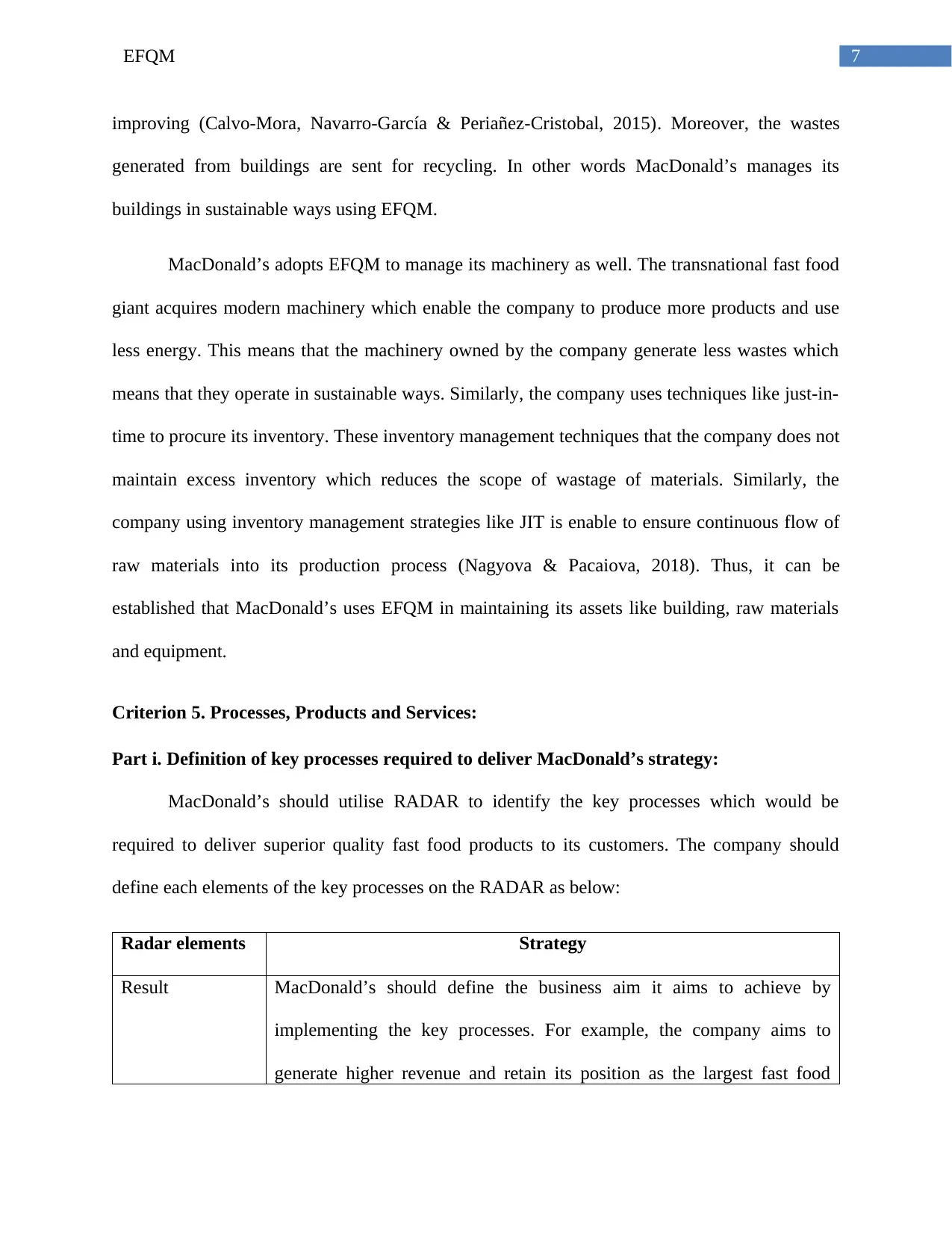
7EFQM
improving (Calvo-Mora, Navarro-García & Periañez-Cristobal, 2015). Moreover, the wastes
generated from buildings are sent for recycling. In other words MacDonald’s manages its
buildings in sustainable ways using EFQM.
MacDonald’s adopts EFQM to manage its machinery as well. The transnational fast food
giant acquires modern machinery which enable the company to produce more products and use
less energy. This means that the machinery owned by the company generate less wastes which
means that they operate in sustainable ways. Similarly, the company uses techniques like just-in-
time to procure its inventory. These inventory management techniques that the company does not
maintain excess inventory which reduces the scope of wastage of materials. Similarly, the
company using inventory management strategies like JIT is enable to ensure continuous flow of
raw materials into its production process (Nagyova & Pacaiova, 2018). Thus, it can be
established that MacDonald’s uses EFQM in maintaining its assets like building, raw materials
and equipment.
Criterion 5. Processes, Products and Services:
Part i. Definition of key processes required to deliver MacDonald’s strategy:
MacDonald’s should utilise RADAR to identify the key processes which would be
required to deliver superior quality fast food products to its customers. The company should
define each elements of the key processes on the RADAR as below:
Radar elements Strategy
Result MacDonald’s should define the business aim it aims to achieve by
implementing the key processes. For example, the company aims to
generate higher revenue and retain its position as the largest fast food
improving (Calvo-Mora, Navarro-García & Periañez-Cristobal, 2015). Moreover, the wastes
generated from buildings are sent for recycling. In other words MacDonald’s manages its
buildings in sustainable ways using EFQM.
MacDonald’s adopts EFQM to manage its machinery as well. The transnational fast food
giant acquires modern machinery which enable the company to produce more products and use
less energy. This means that the machinery owned by the company generate less wastes which
means that they operate in sustainable ways. Similarly, the company uses techniques like just-in-
time to procure its inventory. These inventory management techniques that the company does not
maintain excess inventory which reduces the scope of wastage of materials. Similarly, the
company using inventory management strategies like JIT is enable to ensure continuous flow of
raw materials into its production process (Nagyova & Pacaiova, 2018). Thus, it can be
established that MacDonald’s uses EFQM in maintaining its assets like building, raw materials
and equipment.
Criterion 5. Processes, Products and Services:
Part i. Definition of key processes required to deliver MacDonald’s strategy:
MacDonald’s should utilise RADAR to identify the key processes which would be
required to deliver superior quality fast food products to its customers. The company should
define each elements of the key processes on the RADAR as below:
Radar elements Strategy
Result MacDonald’s should define the business aim it aims to achieve by
implementing the key processes. For example, the company aims to
generate higher revenue and retain its position as the largest fast food
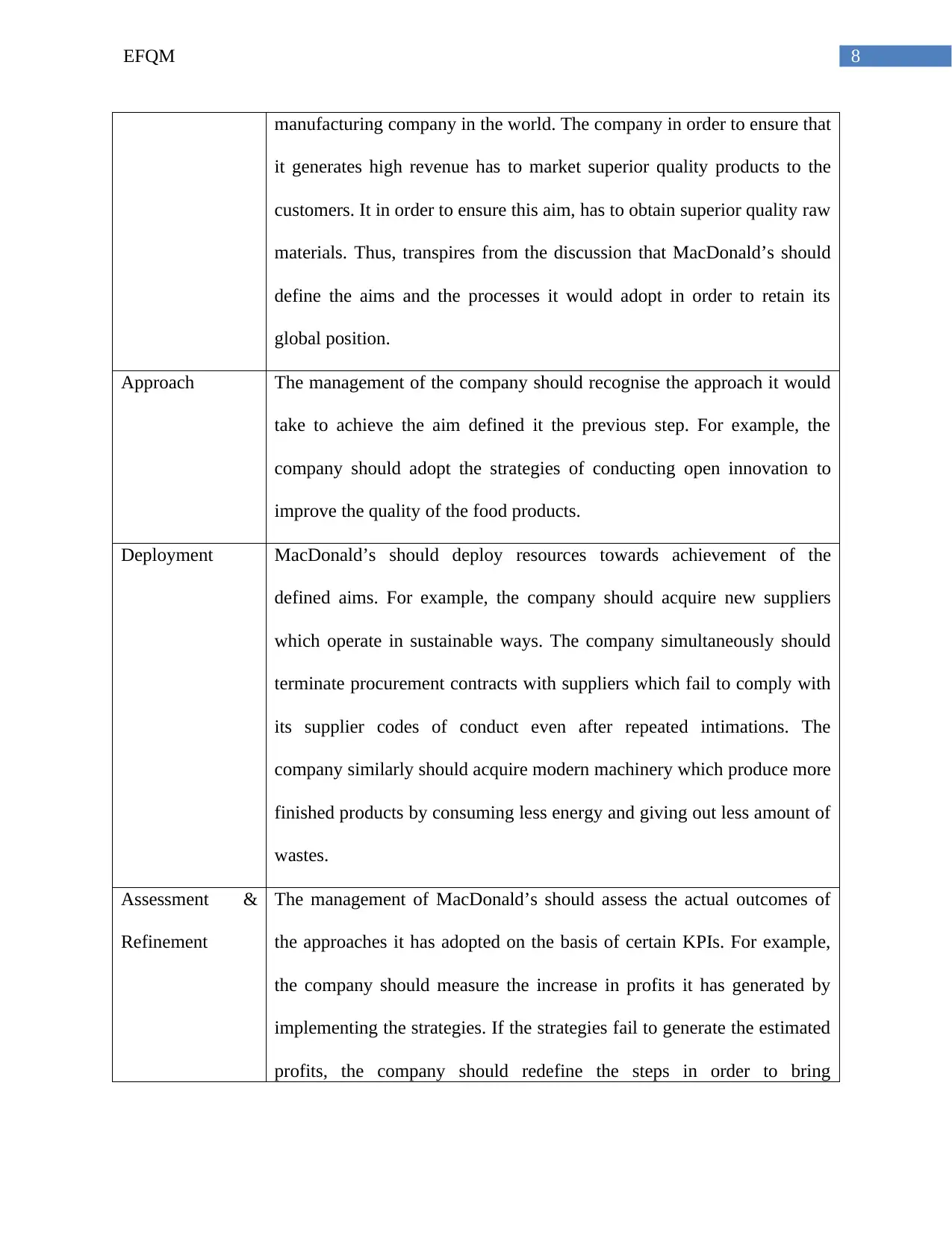
8EFQM
manufacturing company in the world. The company in order to ensure that
it generates high revenue has to market superior quality products to the
customers. It in order to ensure this aim, has to obtain superior quality raw
materials. Thus, transpires from the discussion that MacDonald’s should
define the aims and the processes it would adopt in order to retain its
global position.
Approach The management of the company should recognise the approach it would
take to achieve the aim defined it the previous step. For example, the
company should adopt the strategies of conducting open innovation to
improve the quality of the food products.
Deployment MacDonald’s should deploy resources towards achievement of the
defined aims. For example, the company should acquire new suppliers
which operate in sustainable ways. The company simultaneously should
terminate procurement contracts with suppliers which fail to comply with
its supplier codes of conduct even after repeated intimations. The
company similarly should acquire modern machinery which produce more
finished products by consuming less energy and giving out less amount of
wastes.
Assessment &
Refinement
The management of MacDonald’s should assess the actual outcomes of
the approaches it has adopted on the basis of certain KPIs. For example,
the company should measure the increase in profits it has generated by
implementing the strategies. If the strategies fail to generate the estimated
profits, the company should redefine the steps in order to bring
manufacturing company in the world. The company in order to ensure that
it generates high revenue has to market superior quality products to the
customers. It in order to ensure this aim, has to obtain superior quality raw
materials. Thus, transpires from the discussion that MacDonald’s should
define the aims and the processes it would adopt in order to retain its
global position.
Approach The management of the company should recognise the approach it would
take to achieve the aim defined it the previous step. For example, the
company should adopt the strategies of conducting open innovation to
improve the quality of the food products.
Deployment MacDonald’s should deploy resources towards achievement of the
defined aims. For example, the company should acquire new suppliers
which operate in sustainable ways. The company simultaneously should
terminate procurement contracts with suppliers which fail to comply with
its supplier codes of conduct even after repeated intimations. The
company similarly should acquire modern machinery which produce more
finished products by consuming less energy and giving out less amount of
wastes.
Assessment &
Refinement
The management of MacDonald’s should assess the actual outcomes of
the approaches it has adopted on the basis of certain KPIs. For example,
the company should measure the increase in profits it has generated by
implementing the strategies. If the strategies fail to generate the estimated
profits, the company should redefine the steps in order to bring
⊘ This is a preview!⊘
Do you want full access?
Subscribe today to unlock all pages.

Trusted by 1+ million students worldwide
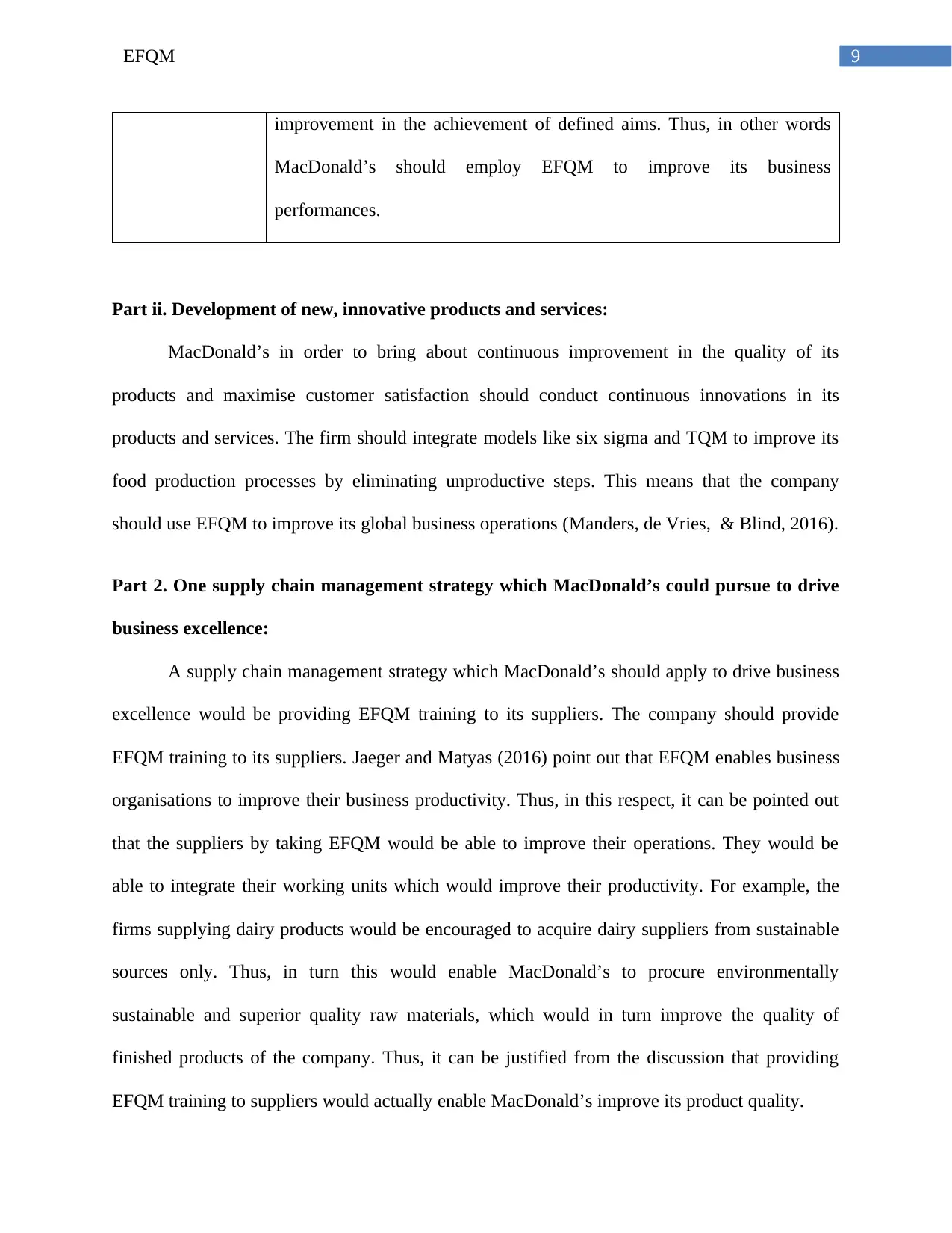
9EFQM
improvement in the achievement of defined aims. Thus, in other words
MacDonald’s should employ EFQM to improve its business
performances.
Part ii. Development of new, innovative products and services:
MacDonald’s in order to bring about continuous improvement in the quality of its
products and maximise customer satisfaction should conduct continuous innovations in its
products and services. The firm should integrate models like six sigma and TQM to improve its
food production processes by eliminating unproductive steps. This means that the company
should use EFQM to improve its global business operations (Manders, de Vries, & Blind, 2016).
Part 2. One supply chain management strategy which MacDonald’s could pursue to drive
business excellence:
A supply chain management strategy which MacDonald’s should apply to drive business
excellence would be providing EFQM training to its suppliers. The company should provide
EFQM training to its suppliers. Jaeger and Matyas (2016) point out that EFQM enables business
organisations to improve their business productivity. Thus, in this respect, it can be pointed out
that the suppliers by taking EFQM would be able to improve their operations. They would be
able to integrate their working units which would improve their productivity. For example, the
firms supplying dairy products would be encouraged to acquire dairy suppliers from sustainable
sources only. Thus, in turn this would enable MacDonald’s to procure environmentally
sustainable and superior quality raw materials, which would in turn improve the quality of
finished products of the company. Thus, it can be justified from the discussion that providing
EFQM training to suppliers would actually enable MacDonald’s improve its product quality.
improvement in the achievement of defined aims. Thus, in other words
MacDonald’s should employ EFQM to improve its business
performances.
Part ii. Development of new, innovative products and services:
MacDonald’s in order to bring about continuous improvement in the quality of its
products and maximise customer satisfaction should conduct continuous innovations in its
products and services. The firm should integrate models like six sigma and TQM to improve its
food production processes by eliminating unproductive steps. This means that the company
should use EFQM to improve its global business operations (Manders, de Vries, & Blind, 2016).
Part 2. One supply chain management strategy which MacDonald’s could pursue to drive
business excellence:
A supply chain management strategy which MacDonald’s should apply to drive business
excellence would be providing EFQM training to its suppliers. The company should provide
EFQM training to its suppliers. Jaeger and Matyas (2016) point out that EFQM enables business
organisations to improve their business productivity. Thus, in this respect, it can be pointed out
that the suppliers by taking EFQM would be able to improve their operations. They would be
able to integrate their working units which would improve their productivity. For example, the
firms supplying dairy products would be encouraged to acquire dairy suppliers from sustainable
sources only. Thus, in turn this would enable MacDonald’s to procure environmentally
sustainable and superior quality raw materials, which would in turn improve the quality of
finished products of the company. Thus, it can be justified from the discussion that providing
EFQM training to suppliers would actually enable MacDonald’s improve its product quality.
Paraphrase This Document
Need a fresh take? Get an instant paraphrase of this document with our AI Paraphraser
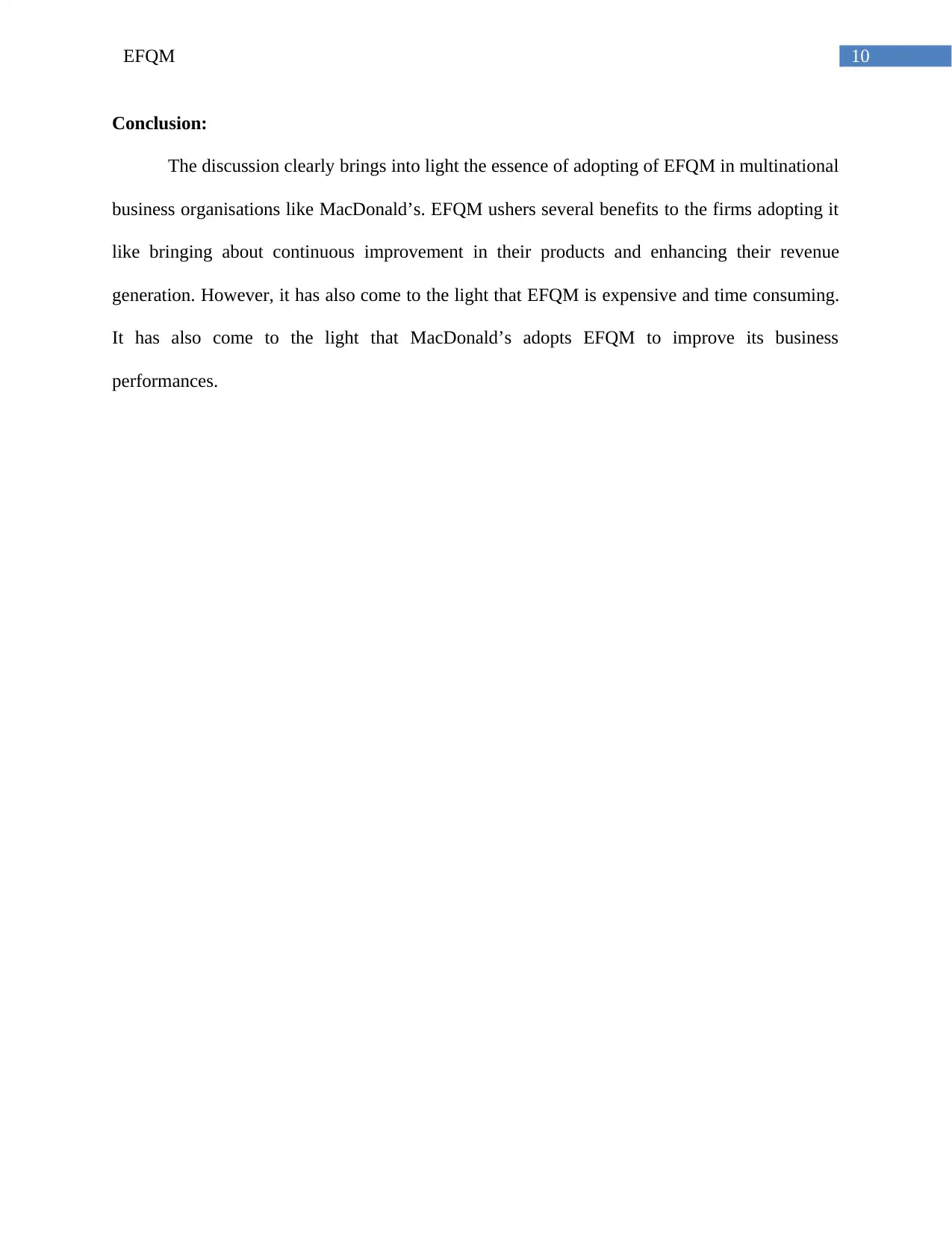
10EFQM
Conclusion:
The discussion clearly brings into light the essence of adopting of EFQM in multinational
business organisations like MacDonald’s. EFQM ushers several benefits to the firms adopting it
like bringing about continuous improvement in their products and enhancing their revenue
generation. However, it has also come to the light that EFQM is expensive and time consuming.
It has also come to the light that MacDonald’s adopts EFQM to improve its business
performances.
Conclusion:
The discussion clearly brings into light the essence of adopting of EFQM in multinational
business organisations like MacDonald’s. EFQM ushers several benefits to the firms adopting it
like bringing about continuous improvement in their products and enhancing their revenue
generation. However, it has also come to the light that EFQM is expensive and time consuming.
It has also come to the light that MacDonald’s adopts EFQM to improve its business
performances.
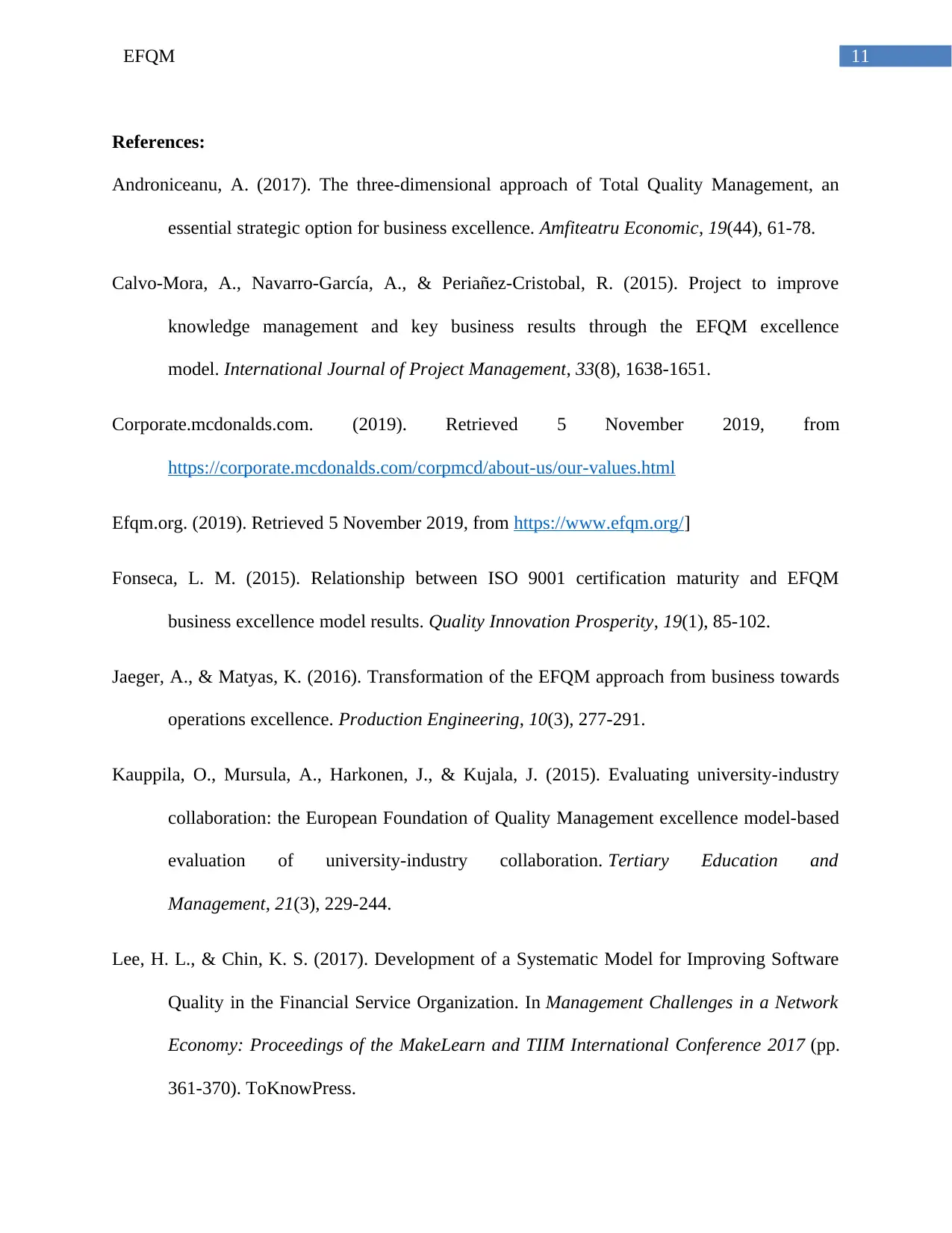
11EFQM
References:
Androniceanu, A. (2017). The three-dimensional approach of Total Quality Management, an
essential strategic option for business excellence. Amfiteatru Economic, 19(44), 61-78.
Calvo-Mora, A., Navarro-García, A., & Periañez-Cristobal, R. (2015). Project to improve
knowledge management and key business results through the EFQM excellence
model. International Journal of Project Management, 33(8), 1638-1651.
Corporate.mcdonalds.com. (2019). Retrieved 5 November 2019, from
https://corporate.mcdonalds.com/corpmcd/about-us/our-values.html
Efqm.org. (2019). Retrieved 5 November 2019, from https://www.efqm.org/]
Fonseca, L. M. (2015). Relationship between ISO 9001 certification maturity and EFQM
business excellence model results. Quality Innovation Prosperity, 19(1), 85-102.
Jaeger, A., & Matyas, K. (2016). Transformation of the EFQM approach from business towards
operations excellence. Production Engineering, 10(3), 277-291.
Kauppila, O., Mursula, A., Harkonen, J., & Kujala, J. (2015). Evaluating university-industry
collaboration: the European Foundation of Quality Management excellence model-based
evaluation of university-industry collaboration. Tertiary Education and
Management, 21(3), 229-244.
Lee, H. L., & Chin, K. S. (2017). Development of a Systematic Model for Improving Software
Quality in the Financial Service Organization. In Management Challenges in a Network
Economy: Proceedings of the MakeLearn and TIIM International Conference 2017 (pp.
361-370). ToKnowPress.
References:
Androniceanu, A. (2017). The three-dimensional approach of Total Quality Management, an
essential strategic option for business excellence. Amfiteatru Economic, 19(44), 61-78.
Calvo-Mora, A., Navarro-García, A., & Periañez-Cristobal, R. (2015). Project to improve
knowledge management and key business results through the EFQM excellence
model. International Journal of Project Management, 33(8), 1638-1651.
Corporate.mcdonalds.com. (2019). Retrieved 5 November 2019, from
https://corporate.mcdonalds.com/corpmcd/about-us/our-values.html
Efqm.org. (2019). Retrieved 5 November 2019, from https://www.efqm.org/]
Fonseca, L. M. (2015). Relationship between ISO 9001 certification maturity and EFQM
business excellence model results. Quality Innovation Prosperity, 19(1), 85-102.
Jaeger, A., & Matyas, K. (2016). Transformation of the EFQM approach from business towards
operations excellence. Production Engineering, 10(3), 277-291.
Kauppila, O., Mursula, A., Harkonen, J., & Kujala, J. (2015). Evaluating university-industry
collaboration: the European Foundation of Quality Management excellence model-based
evaluation of university-industry collaboration. Tertiary Education and
Management, 21(3), 229-244.
Lee, H. L., & Chin, K. S. (2017). Development of a Systematic Model for Improving Software
Quality in the Financial Service Organization. In Management Challenges in a Network
Economy: Proceedings of the MakeLearn and TIIM International Conference 2017 (pp.
361-370). ToKnowPress.
⊘ This is a preview!⊘
Do you want full access?
Subscribe today to unlock all pages.

Trusted by 1+ million students worldwide
1 out of 13
Related Documents
Your All-in-One AI-Powered Toolkit for Academic Success.
+13062052269
info@desklib.com
Available 24*7 on WhatsApp / Email
![[object Object]](/_next/static/media/star-bottom.7253800d.svg)
Unlock your academic potential
Copyright © 2020–2025 A2Z Services. All Rights Reserved. Developed and managed by ZUCOL.





